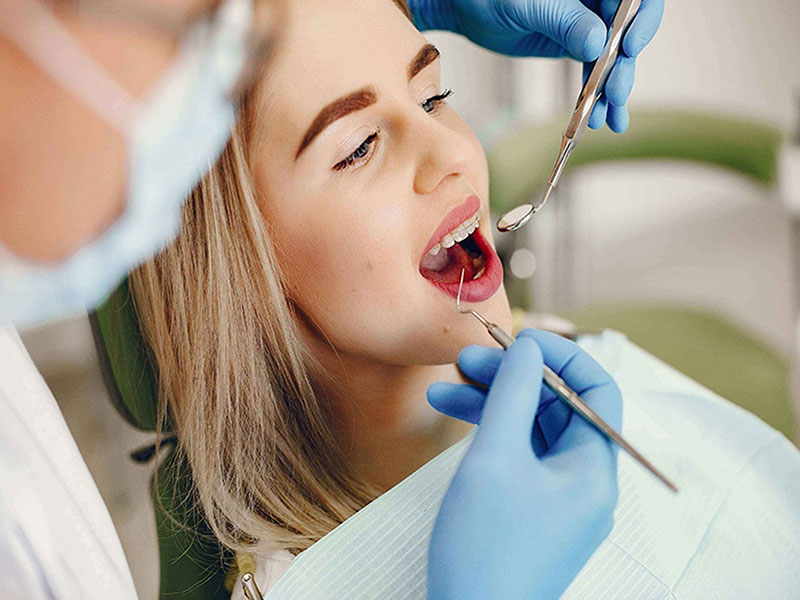Gum Surgery or Periodontal Surgery
What is gum surgery? Sometimes, periodontal surgery may be required to treat certain gum diseases and conditions, such as gingivitis or periodontitis. This type of surgery is commonly referred to as gum surgery.
The goal of this procedure is to treat gum disease and its resulting damage through the following actions:- Regrowth of damaged bones and tissues
- Prevention of tooth loss
- Reduction of the gap between teeth, known as the black triangle
- Reshaping of the jaw to reduce the risk of bacteria growth in bone crevices
- Elimination of infection and bacterial growth
In this article, we will examine the outcomes of periodontal surgery, the conditions that can be treated with this method, and the recovery period after surgery.
What Diseases Does Gum Surgery Treat?
Gum diseases such as gingivitis and periodontitis may require surgical treatment.
Gingivitis is a mild form of gum disease that can cause redness, swelling, and bleeding of the gums. Most of the time, gingivitis is caused by poor oral hygiene, plaque buildup, and tartar accumulation. Professional treatment can resolve this issue.
Periodontitis is a more severe form of gum disease, in which the inflammation of the gums is more intense and advanced, leading to an inflammatory response that destroys the surrounding bones and tissues.
During this inflammatory process, the gums gradually separate from the teeth, creating spaces called pockets, which in turn trap bacteria and lead to infections. As a result, tooth loss and bone damage may occur.
Types of Surgical Methods
The type of surgery performed by the dentist depends on the type and severity of the gum disease.
Before the surgery, the dentist may clean the gums. A procedure known as deep cleaning can remove plaque and bacteria from the teeth and gums.
Another method known as root planing can smooth the surface of the teeth’ roots, leaving fewer places for plaque and bacteria to accumulate. This method also removes any tartar on the roots.
Flap Surgery
Flap surgery is particularly useful for people who have tartar deposits in deep pockets. This method involves lifting the gums off the teeth to remove tartar buildup.
Once the dentist has cleaned the area and removed the tartar, the gums are reattached to their original position around the teeth. Sometimes, during this procedure, the bone may also need to be reshaped.
Bone Grafting
When the bone surrounding the tooth root is damaged or lost, a bone graft may be necessary. This method involves replacing the damaged bone with new bone. The new bone may be the patient’s own bone, manufactured bone, or a bone graft from another person.
The goal of bone grafting is to keep the tooth in place and promote its regrowth.
Providing all specialized dental services, including implants, orthodontics, cosmetic dentistry, surgery, and specialized treatments for children at Dr. Damghanipour’s specialized dental clinic.

Guided Tissue Regeneration
In this procedure, the dentist places a small piece of mesh-like material between the bone and the gum tissue. This material prevents the gum from growing into the area where the bone should be, allowing the bone and connective tissue to regenerate.
Tissue Grafting
Gum recession, known as gingival recession, is caused by the loss of gum tissue and may require soft tissue grafting to reduce the risk of further damage.
During this procedure, a dentist typically removes tissue from another part of the body and reattaches it to the area where the gum has receded. The grafted tissue is often taken from the roof of the mouth.
Tissue grafting not only reduces the risk of further damage but also covers the exposed roots.
Other Treatment Options Include:
- Laser Therapy: Although current evidence does not fully support laser therapy, some dentists use it to reduce pocket sizes and repair damaged connective tissue.
- Tissue-Stimulating Proteins: This method involves using a gel containing proteins to stimulate bone and tissue growth.
Recovery
An antiseptic mouthwash may help prevent infection after the surgery.
After any dental procedure, the dentist provides detailed instructions on how to achieve the best possible recovery. The recovery time depends on the extent of the surgery.
Typically, individuals will need pain relievers in the days following gum surgery. Again, it is emphasized that the dentist will discuss the recommended medications before the patient leaves the office.
The dentist may also recommend the following:- Use an antiseptic mouthwash to keep the area clean and prevent infection
- Avoid heavy exercise
- Eat soft foods in the days following the surgery
- Avoid smoking and using hookah
The dentist will tell you to visit him 1-2 weeks after the procedure. During this visit, he will check the healing of the gums and remove the stitches if necessary.
The appearance and feel of the gums will be different after the surgery. The gums and teeth will heal and become stronger and firmer. Some individuals may experience tooth sensitivity to hot or cold temperatures, which can be relieved with desensitizing toothpaste.
Your dentist will discuss follow-up appointments to maintain oral health in the future.
